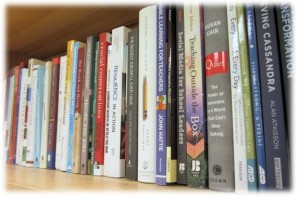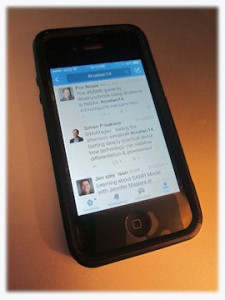 Each year, our school division holds a “Summer Institute” for teachers, the purpose of which is to provide two days of professional development just prior to the start of the new school year. In examining the topics the Institute was considering last spring, I detected a lack of activities related to current learning technologies and, with a colleague, offered to fill the void.
Each year, our school division holds a “Summer Institute” for teachers, the purpose of which is to provide two days of professional development just prior to the start of the new school year. In examining the topics the Institute was considering last spring, I detected a lack of activities related to current learning technologies and, with a colleague, offered to fill the void.
Our offer was welcomed and despite the end of the school year being a very busy time, we managed to do some collaborative planning. My colleague is skilled at locating and implementing new learning technologies in the classroom. Selective about what she uses in the classroom, I suspect that for every app, program, or device that becomes a part of her teaching, many more fail to make the cut on the basis not doing enough to improve the learning of her students.
Take The Risk
I envisioned my role in the presentation would be less about new technologies and more about encouraging people to step out of their comfort zone. Changing our practice is rooted in risk taking. That can provoke a measure of anxiety in anyone, but even more so for teachers; the risks they take have the potential to impact on the students for which they are accountable. There is comfort in staying with the tried and true. What is to be gained from stepping away from that?
- I often consider why, in this day and age, anyone in the educational system would not actively leverage the professional networking power of Twitter to build upon their skill set.
- I wonder why they would not embrace powerful new communication technologies instead of relying on traditional but less effective technologies.
- I reflect upon classroom practices rooted in traditional teaching which, while still valid, can be transformed through the use of common and easily accessed technological resources that are typically available in practically every classroom.
What’s Stopping You?
In all of these cases I believe that at least one of two conditions exists, which can be summarized by these statements:
- “What I am doing is working for me, so that is good enough.”
- “I don’t have the time learn all of this.”
Regarding the first statement, finding what works is important. But simply leaving it at that is not enough. We should expect more from people at all levels within the school system. A community of learners will continually seek out new and improved ways of doing things. From time to time that will mean changing long standing practice, as uncomfortable as that may be. Sticking with the status quo is simply unacceptable.
Regarding the second statement, it is true that time is at a premium. The challenge is to help people see how investing time in learning something new can lead to greater efficiency and actually save some of that precious time in the long run. Professional educators, of all people, should understand this. It is also not a matter of learning “all of this”, but selectively investing in those things which may yield the greatest return.
Inspiring Change
As I prepare for our Summer Institute presentation, I will need to focus on both of these statements. My task is to inspire people to look beyond the status quo and instill the confidence they need to make the leap to the next level. Professional development sessions like our Summer Institute are critical components in facilitating the system wide cultural shifts that are required for this to happen.
Some time ago, I wrote about exploiting technology for effective school administration. The barriers we faced then still exist today, but I am encouraged by the progress I have observed. That progress has only occurred where people have embraced the message I hope to bring to the upcoming PD session:
Take the risk, and leave your comfort zone behind.







